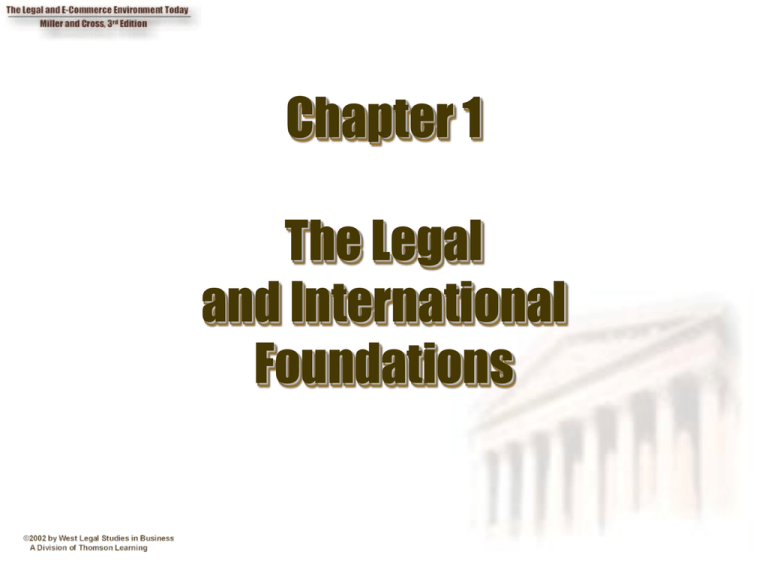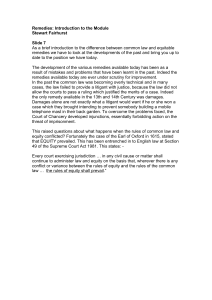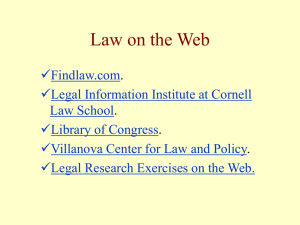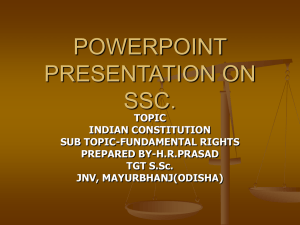The Legal and International Foundation
advertisement

Chapter 1 The Legal and International Foundations Chapter Objectives 1. Explain what is generally meant by the term law. 2. Describe the origins and importance of the common law tradition. 3. Identify the four major sources of American law. 4. List some important classifications of law. 5. Distinguish between national law and international law. 2 The Nature of Law Law is a body of enforceable rules governing relationships among individuals and between individuals and their society. Three important schools of legal thought: Natural law tradition Legal positivism Legal realism 3 Natural Law Tradition One of the oldest and most significant schools of legal thought. Those who believe in natural law hold there is a universal law applicable to all human beings and that this law is of a higher order than positive, or conventional law. 4 Legal Positivism A school of legal thought centered on the assumption that there is no law higher than the laws created by the government. Laws must be obeyed, even if they are unjust, to prevent anarchy. 5 Legal Realism A popular school of legal thought during the 1920s and 1930s. Legal realists generally advocated a less abstract and more realistic approach to the law, an approach that would take into account customary practices and the circumstances in which transactions take place. The school left a lasting imprint on American jurisprudence. 6 The Common Law Tradition The Common Law originated in medieval England with the creation of the king’s courts, or curia regis, and the development of a body of rules that were applied throughout the land. 7 Stare Decisis A doctrine under which judges “stand on decided cases,” or follow the rule of precedent, in deciding cases. Stare decisis is the cornerstone of the common law tradition. 8 Legal and Equitable Remedies Remedies at law: Money, property, land or something else of value Remedies in equity: Remedies that are granted when the remedies at law are unavailable or inadequate Equitable remedies include: Specific performance Injunction Contract rescission (cancellation) 9 10 Equitable Principles and Maxims Where there is equal equity, the law must prevail. One seeking the aid of an equity court must come to the court with clean hands. Equity will not suffer a wrong without a remedy. Equity regards substance rather than form. Equity aids the vigilant, not those who rest on their rights. Whoever seeks equity must do equity. Why would equity courts give credence to such general maxims rather than to a hard-and-fast body of law? 11 Sources Of American Law Constitutional Law Statutory Law Administrative Law Case Law and Common Law Doctrines 12 Sources of American Law Which source of law takes priority in the following situations, and why? A federal statute conflicts with the U.S. Constitution. A federal statute conflicts with a state constitution. A state statute conflicts with the common law of that state. A state constitutional amendment conflicts with the U.S. Constitution. A federal administrative regulation conflicts with a state constitution. 13 Constitutional Law The law as expressed in the U.S. Constitution and the various state constitutions. The U.S. Constitution is the supreme law of the land. State constitutions are supreme within state borders to the extent that they do not violate the U.S. Constitution or a federal law. 14 Statutory Law Laws or ordinances created by federal, state, and local legislatures and governing bodies. None of these laws can violate the U.S. Constitution or the relevant state constitutions. Uniform laws, when adopted by a state legislature, become statutory law in that state. 15 Administrative Law The rules, orders, regulations, and decisions of federal, state, or local government administrative agencies. Federal administrative agencies are created by enabling legislation enacted by the U.S. Congress. Agency functions include: Rulemaking Investigation and enforcement Adjudication 16 Administrative Agencies The Constitution authorizes only the legislative branch to create laws. Administrative agencies, however, which are not specifically referred to in the Constitution, make rules that are as legally binding as laws passed by Congress. Is there any way to avoid placing so much power in the hands of administrative agencies? Is there any practical alternative? 17 Case Law and Common Law Doctrines Judge-made law, including interpretations of constitutional provisions, of statutes enacted by legislatures, and of regulations created by administrative agencies. The common law, the doctrines and principles embodied in case law, governs all areas not covered by statutory law or agency regulations issued to implement various statutes. 18 Classifications of Law The law may be broken down according to several classification systems, such as: Substantive vs. Procedural law Civil vs. Criminal law Federal vs. State law National vs. International law Private vs. Public law 19 20 Online Legal Research The world of legal research is rapidly changing. How has current technology changed the methods of legal research? Describe what a law and legal research library might consist of in the future. 21 National and International Law Increasingly, businesspersons in the U.S. are engaging in transactions that extend beyond our national borders. National law vs. International law What’s the difference? Key difference is that national law can be enforced by government authorities. What government can enforce international law? 22 National Law Definition: law that pertains to a particular nation. Most nations today have either a common law system or a civil law system. 23 Common Law System Generally, those countries that were once colonies of Great Britain retained their English common law heritage after they achieved their independence. The doctrine of stare decisis is the cornerstone of the common law tradition. 24 25 Civil Law System A legal system stemming from Roman “code law,” in which the primary source of law is a statutory code—an ordered grouping of legal principles enacted into law by a legislature or governing body. Precedents are not binding in a civil law system because they do not follow the doctrine of stare decisis. 26 International Law A body of written and unwritten laws observed by independent nations and governing the acts of individuals as well as governments. Sources of international law include: National laws Customs Treaties International organizations and conferences 27 Cultural Differences Suppose that John, the president of a U.S. bank, wants to take his top vice president, Carla, with him to a meeting overseas. John is advised that he would lose respect in the eyes of the overseas company if he took Carla, a woman, with him. List some of the pros and cons of taking Carla to the meeting that John should consider in making his decision. 28 For Review 1. What is the common law tradition? 2. What is a precedent? When might a court depart from precedent? 3. What is the difference between remedies at law and remedies in equity? 4. What is the Uniform Commercial Code? 5. What is the difference between civil law and criminal law? 29





